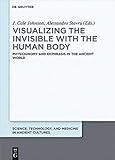Visualizing the Invisible with the Human Body : Physiognomy and Ekphrasis in the Ancient World.
Yazar:Johnson, J. Cale
Katkıda bulunan(lar):Stavru, Alessandro
Materyal türü: KonuSeri kaydı: Yayıncı: Berlin/Boston : Walter de Gruyter GmbH, 2019Telif hakkı tarihi: �2020Tanım: 1 online resource (508 pages)İçerik türü:text Ortam türü:computer Taşıyıcı türü: online resourceISBN: 9783110642698Tür/Form:Electronic books.Ek fiziksel biçimler:Print version:: Visualizing the Invisible with the Human BodyDDC sınıflandırma: 809 Çevrimiçi kaynaklar: Click to View
KonuSeri kaydı: Yayıncı: Berlin/Boston : Walter de Gruyter GmbH, 2019Telif hakkı tarihi: �2020Tanım: 1 online resource (508 pages)İçerik türü:text Ortam türü:computer Taşıyıcı türü: online resourceISBN: 9783110642698Tür/Form:Electronic books.Ek fiziksel biçimler:Print version:: Visualizing the Invisible with the Human BodyDDC sınıflandırma: 809 Çevrimiçi kaynaklar: Click to View Intro -- Contents -- Introduction to "Visualizing the invisible with the human body: Physiognomy and ekphrasis in the ancient world" -- Part I: Mesopotamia and India -- 1. Demarcating ekphrasis in Mesopotamia -- 2. Mesopotamian and Indian physiognomy -- 3. Umṣatu in omen and medical texts: An overview -- 4. The series Šumma Ea liballiṭka revisited -- 5. Late Babylonian astrological physiognomy -- Part II: Classical Antiquity -- 6. Pathos, physiognomy and ekphrasis from Aristotle to the Second Sophistic -- 7. Iconism and characterism of Polybius Rhetor, Trypho and Publius Rutilius Lupus Rhetor -- 8. Physiognomic roots in the rhetoric of Cicero and Quintilian: The application and transformation of traditional physiognomics -- 9. Good emperors, bad emperors: The function of physiognomic representation in Suetonius' De vita Caesarum and common sense physiognomics -- 10. Physiognomy, ekphrasis, and the 'ethnographicising' register in the second sophistic -- 11. Representing the insane -- Part III: Semitic traditions -- 12. The question of ekphrasis in ancient Levantine narrative -- 13. Physiognomy as a secret for the king. The chapter on physiognomy in the pseudo-Aristotelian "Secret of Secrets" -- 14. Ekphrasis of a manuscript (MS London, British Library, Or. 12070). Is the "London Physiognomy" a fake or a "semi-fake," and is it a witness to the Secret of Secrets (Sirr al-Asrār) or to one of its sources? -- 15. A lost Greek text on physiognomy by Archelaos of Alexandria in Arabic translation transmitted by Ibn Abī Ṭālib al-Dimashqī: An edition and translation of the fragments with glossaries of the Greek, Syriac, and Arabic traditions -- Index.
STMAC aims to advance an inter-disciplinary and inclusive approach to the study of science in the ancient world, ranging from mathematics and physics, medicine and magic to astronomy, astrology, and divination and covering the Mediterranean world, the Near (Middle) East, and Central and East Asia. The series is open to different types of publications including monographs and edited volumes as well as text editions and commentaries.
Description based on publisher supplied metadata and other sources.
Electronic reproduction. Ann Arbor, Michigan : ProQuest Ebook Central, 2022. Available via World Wide Web. Access may be limited to ProQuest Ebook Central affiliated libraries.







There are no comments on this title.